
Published: August, 1963
Story: Stan Lee
Pencils: Jack Kirby
Inks: Dick Ayers
Letters: Art Simek
Okay. I have a couple of things to say, and you might not like it. While this story was okay, I experienced a level of frustration in just about every aspect. I kept waiting for a big moment in the history of the Fantastic Four, but mostly, this was simply more of the same old thing. And the same old thing is getting old.
First, a brief synopsis:
Doctor Doom kidnaps Alicia and sets a trap to destroy the Fantastic Four, should they attempt to rescue her from his sanctum sanctorum in the clouds. However, Reed’s potion temporarily reverts Thing to Ben Grimm so he can break through Doom’s disintegrator defenses and disable the diabolical device. The others follow, and all must escape a number of booby traps. Eventually, Alicia is rescued, but Doom escapes.
That went quickly, didn’t it? I’ve got it down to the bare bones, but then, the actual STORY is a bare bones affair. Let’s take a closer look at what else is going on.

As I began reading, I kept looking at the page numbers, wondering when some real action would start up. First we rehash the previous issue, then go into a couple of comedy bits, before some semblance of a story finally gets underway on page five. We spend a couple more pages with Doom’s floating marshmallow men chasing the four all over the city, scratching our heads and asking, “What the…?”
Finally, on page nine, the real story kicks in.
Yes, it takes until page nine of 22 before we know where this story is going. But even then, it doesn’t go far, since this is a mostly forgettable tale that simply revisits the same themes we’ve seen thus far in the FF series.
For instance:
Once again, we are reminded how fortunate the FF are to have a brilliant scientist on their team. Reed employs an electro scanner, a modified electro-detector, a magnetically powered one man plastic bubble, a highly refined radar set, and of course the volatile serum that transforms Thing to Ben Grimm. I’m tellin’ ya, this guy is more useful than McGyver!
But we already knew that.
 However, you’d think the others would realize it, right? Wrong. Because immediately after Thing frantically wonders if there’s really some way to fight Doom, and Reed replies, “There is, old friend!” Sue chimes in with, “Oh Reed! If only you COULD find a way!” Hello, Sue! Haven’t you been paying attention? Didn’t Reed just boldly assert that he’d found a way? Sue needs to get with the program and realize that when her boyfriend says he’s got a plan to outwit the villain, it’s all over, ’cept for the crying.
However, you’d think the others would realize it, right? Wrong. Because immediately after Thing frantically wonders if there’s really some way to fight Doom, and Reed replies, “There is, old friend!” Sue chimes in with, “Oh Reed! If only you COULD find a way!” Hello, Sue! Haven’t you been paying attention? Didn’t Reed just boldly assert that he’d found a way? Sue needs to get with the program and realize that when her boyfriend says he’s got a plan to outwit the villain, it’s all over, ’cept for the crying.
Of course, in grand Fantastic Four tradition, Reed does not win the day on his own. Thing employs sheer brute strength, Johnny throws “flame images” to confuse Doom, and Sue also does her part with trickery and invisibility. Teamwork! As usual, each plays an essential part in their success—a part none of the others have the means to accomplish.
So they rescue Alicia, but once again, in the end, Doom escapes! Here’s where I have a problem. How many times have we seen Doom escape so far? Three? Four? Five? As I said: more of the same.
I’m relatively new to comics, so forgive me if I’m misinterpreting, but to my way of thinking, there’s a danger in continually allowing the villain to escape. Obviously there’s a danger to the good citizens of the Marvel Universe, if wild maniacs continue to run amok, but I’m not talking about that. It concerns me that each time Doom and the FF tangle, with neither gaining the upper hand—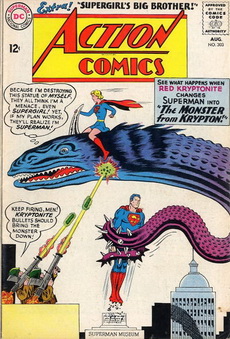 they simply spar, cause minor damage, then retreat to fight again—the readers may be increasingly apt to sigh, “Ho hum, ho hum…what else is new? Hey! Maybe I should check out what Superman’s been up to!”
they simply spar, cause minor damage, then retreat to fight again—the readers may be increasingly apt to sigh, “Ho hum, ho hum…what else is new? Hey! Maybe I should check out what Superman’s been up to!”
Of course, Superman is probably doing just about the same as the FF, battling fierce villains that inexplicably cannot be captured and subdued, despite all the amenities at the heroes’ disposal. Admittedly, the FF and Doom are equally powerful forces for good and evil, but how long can they go on butting heads like this? If one side doesn’t eventually outshine the other, the battle is bound to lose its luster for the readers.
Readers will start asking themselves: How good can the Fantastic Four be, if they continually FAIL to subdue Doctor Doom? And how villainous is Doom, if he can never get anywhere close to achieving his goal of destroying the Fantastic Four? And then the inevitable and terrifying possibility: maybe, rather than both sides being equally good, they are both equally awful.
I discussed this with Russ, and he reminded me that, at least at this point in the Marvel Universe, the FF are not attempting to “bring Doom to justice,” or capture him to be sent to jail, they are simply reacting to whatever fire he has set to get their attention. Last time, they were all about helping the citizens of Micro-World. Before that, the main order of business was to get Reed and Doom back into their own bodies, so Doom would stop his disguised shenanigans. Here, the only objective is to rescue Alicia. And they do that. So yeah, I guess you could say the Fantastic Four are indeed “successful.”
 But what about Doom? Is he successful? His prime directive: destroy the FF. On the surface, he’s consumed by hatred for the group—however, if you look closer, the driving force in this hatred is a raging jealousy against old classmate, Reed Richards. That jealousy is evident in everything Doom does. I’ve talked before about how Doom may be a lonely, bitter figure who, in addition to despising his intellectual rival’s achievements, also resents Reed’s close bonds of friendship and love. Doom’s desire to destroy the FF is ultimately an attempt to obliterate everything Reed Richards both IS and HAS.
But what about Doom? Is he successful? His prime directive: destroy the FF. On the surface, he’s consumed by hatred for the group—however, if you look closer, the driving force in this hatred is a raging jealousy against old classmate, Reed Richards. That jealousy is evident in everything Doom does. I’ve talked before about how Doom may be a lonely, bitter figure who, in addition to despising his intellectual rival’s achievements, also resents Reed’s close bonds of friendship and love. Doom’s desire to destroy the FF is ultimately an attempt to obliterate everything Reed Richards both IS and HAS.
However, if Doom wasn’t—as Russ puts it—such a “noble villain,” he could have easily made more progress by this time. In this story alone, I have to ask: if Doom is really so “diabolical,” why does he simply kidnap Alicia? Why not kill her as well? The four would still attempt a rescue, and if for some reason, Doom’s disintegrator failed to destroy them, he would still have achieved the psychological advantage of causing our heroes unbearable guilt and agony when they arrive on the scene to find Alicia dead.
So. Why do we not go there? Will Doom not murder a defenseless female because he is a “noble villain”? But what good is nobility to a villain, if it doesn’t contribute to his villainy? Or is it an external story reason? Perhaps it is Stan who is unwilling to kill the defenseless female, fearing that the audience might not accept and appreciate Alicia’s murder? Was thought given to the tender constitutions of the little boys and young men, who may have been uncomfortable imagining their own mothers and sisters and girlfriends suffering Alicia’s fate? Nowadays, anything goes, but back in the happy-go-lucky 1960’s, perhaps our comic book villains needed to be more “comics” and less VILLAIN. I feel here that Doom is simply playing at being a villain, rather than jumping into the role with all the gusto of, let’s say, a Freddie Krueger or Hannibal Lecter.
 Well…okay. Maybe the social climate of the era has some effect on the acceptable level of villainy, but what about this odd bit: In this story, Doom suddenly aspires to become part of the Presidential Cabinet. Huh?? What?? That doesn’t sound like a mad despot to me! Doom seems the type to want to usurp the President himself, or more likely, install himself as Ruler of the Universe. I simply can’t imagine him playing nice with the other Cabinet members. Anything resembling “civil servant” just doesn’t ring true for the dreaded Doctor Doom. Trying to figure out this peculiar development, all I can come up with is that Stan and Jack were simply looking for an easy way to work in JFK’s forehead.
Well…okay. Maybe the social climate of the era has some effect on the acceptable level of villainy, but what about this odd bit: In this story, Doom suddenly aspires to become part of the Presidential Cabinet. Huh?? What?? That doesn’t sound like a mad despot to me! Doom seems the type to want to usurp the President himself, or more likely, install himself as Ruler of the Universe. I simply can’t imagine him playing nice with the other Cabinet members. Anything resembling “civil servant” just doesn’t ring true for the dreaded Doctor Doom. Trying to figure out this peculiar development, all I can come up with is that Stan and Jack were simply looking for an easy way to work in JFK’s forehead.
So I end this entry with a mighty…SIGH. More questions than answers. However, I did enjoy these amusing bits:

 From the ridiculous to the sublime: A bystander observes of the mighty Thing, “He’s so grotesque that he’s almost beautiful!”
From the ridiculous to the sublime: A bystander observes of the mighty Thing, “He’s so grotesque that he’s almost beautiful!”
Sue’s floating “follower” has pink polka dots, whereas the others are plain white, a cross between the Michelin Man and the Pillsbury Doughboy.
While Ben travels in the “silent, transparent, magnetically-powered one man plastic bubble,” looking more than anything like an illustration from a 5th grade health film about reproduction, he exclaims “Made it!! I’ve PENETRATED Doom’s disintegrator defenses!”  This is not the first time I’ve noticed an image or remark that could be misinterpreted by “dirty minds,” and it makes me wonder if anyone has ever written a book or done a scholarly paper on Freudian and sexual symbolism in the world of Marvel Comics.
This is not the first time I’ve noticed an image or remark that could be misinterpreted by “dirty minds,” and it makes me wonder if anyone has ever written a book or done a scholarly paper on Freudian and sexual symbolism in the world of Marvel Comics.
Well, that’s all I have to say about this story. A few good moments, but mostly, just more of the same, and some of it doesn’t hold together very well for me. I notice that the cover proclaims the FF are “In the Clutches of Doctor Doom!” but I’m looking forward to the day when Doom does not so easily escape the clutches of the Fantastic Four. I can’t wait to see what happens when both sides finally take off the kid gloves and seriously get down to business.
![]() Next time in the Marvelous Zone, our hero gets right to the business of disabling the villain, and he doesn’t care if he has to cross time and space to do it. He’ll do what has to be done…and look good doing it!
Next time in the Marvelous Zone, our hero gets right to the business of disabling the villain, and he doesn’t care if he has to cross time and space to do it. He’ll do what has to be done…and look good doing it!
| Want to read this comic on your computer? Marvel has a scan! Want to own this story? Buy the Masterworks! |

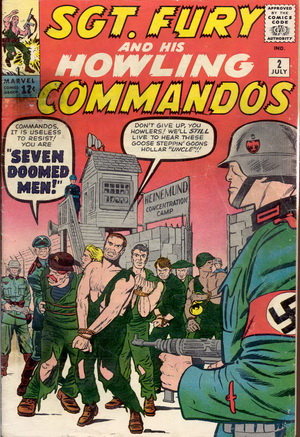

 And later, we get even more information, so that it doesn’t matter whether or not you ever read the first Egghead vs. Ant-Man story, because the entire thing is rehashed in the first page and a half.
And later, we get even more information, so that it doesn’t matter whether or not you ever read the first Egghead vs. Ant-Man story, because the entire thing is rehashed in the first page and a half. 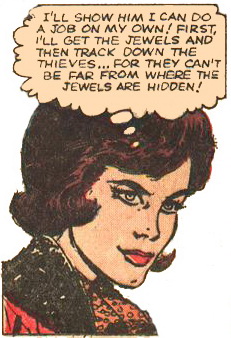 Striker, a respected zoologist, who devises a convoluted plan to capture the Wasp by first stealing a famous diamond. There are a lot of steps in this plan, and Ape and Twister don’t understand why it has to be so complicated, and frankly, neither do I. But when Janet van Dyne shows up at the Professor’s wasp exhibit and sees the stolen jewels hidden in a wasp’s nest, she makes the bold decision to solve the crime on her own, so Henry will stop thinking of her as “a scatterbrained little girl.”
Striker, a respected zoologist, who devises a convoluted plan to capture the Wasp by first stealing a famous diamond. There are a lot of steps in this plan, and Ape and Twister don’t understand why it has to be so complicated, and frankly, neither do I. But when Janet van Dyne shows up at the Professor’s wasp exhibit and sees the stolen jewels hidden in a wasp’s nest, she makes the bold decision to solve the crime on her own, so Henry will stop thinking of her as “a scatterbrained little girl.” More importantly, though, the Wasp finds the one thing she previously lacked: real power! It’s not enough to be small and look cute in your costume, a REAL wasp has a stinger! And now our little superheroine has advanced to a higher level with the discovery of her own distinct WEAPON. It seems unlikely a small girl with a straight pin could cause any real damage, but in this story, Wasp gets the job done…and with gusto!
More importantly, though, the Wasp finds the one thing she previously lacked: real power! It’s not enough to be small and look cute in your costume, a REAL wasp has a stinger! And now our little superheroine has advanced to a higher level with the discovery of her own distinct WEAPON. It seems unlikely a small girl with a straight pin could cause any real damage, but in this story, Wasp gets the job done…and with gusto!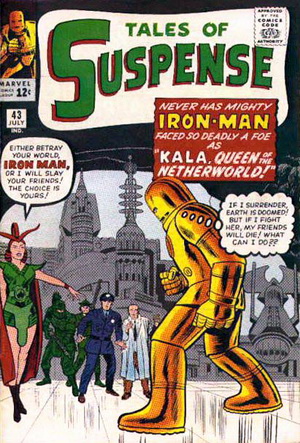
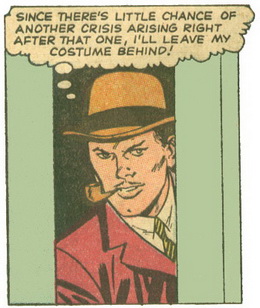 heads up every time, what are the odds it will land heads up again on your 50th throw? Still 50 /50! I know it seems odd, but those are the mathematical facts. Boggles my mind, that’s for sure. In the same way, the recent occurrence of one crisis does nothing to deter the possibility of a crisis in the immediate future. And frankly, I’m disappointed in Tony Stark, with all his smarts, not recognizing that.
heads up every time, what are the odds it will land heads up again on your 50th throw? Still 50 /50! I know it seems odd, but those are the mathematical facts. Boggles my mind, that’s for sure. In the same way, the recent occurrence of one crisis does nothing to deter the possibility of a crisis in the immediate future. And frankly, I’m disappointed in Tony Stark, with all his smarts, not recognizing that. 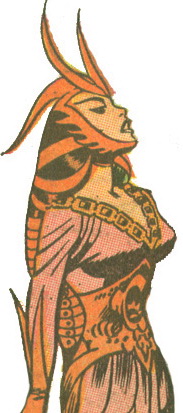 and probably killed his boss, which is never a good thing.
and probably killed his boss, which is never a good thing. 
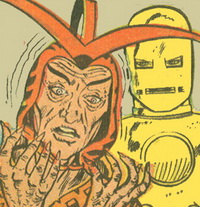 surfaceman outmaneuvers her. Confusing Kala with multiple mirror images of himself, Iron Man grabs the evil queen and transports her to the surface, where she immediately ages into a hideous old hag.
surfaceman outmaneuvers her. Confusing Kala with multiple mirror images of himself, Iron Man grabs the evil queen and transports her to the surface, where she immediately ages into a hideous old hag. 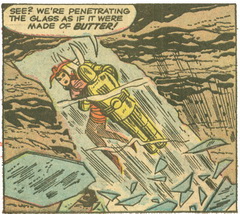 But the female Kala is so softened after her encounter with Iron Man, she’s almost a different person. As Iron Man softens the Netherwold’s protective glass dome “as if it were butter,” likewise, he softens Kala. And is it lost on anyone that Kala’s epic adventure involves both the act of penetration and “a nice, wide shaft”? Did Stan know what he was doing here, or is this simply a fortunately Freudian turn of phrase?
But the female Kala is so softened after her encounter with Iron Man, she’s almost a different person. As Iron Man softens the Netherwold’s protective glass dome “as if it were butter,” likewise, he softens Kala. And is it lost on anyone that Kala’s epic adventure involves both the act of penetration and “a nice, wide shaft”? Did Stan know what he was doing here, or is this simply a fortunately Freudian turn of phrase?  I don’t know if we will see Kala or her Netherworld again, and if we don’t, I’ll be disappointed, because I saw potential in this scientifically advanced society that also has strong mythical ties to the lost city of Atlantis. And I especially liked the idea of a strong, beautiful woman leader.
I don’t know if we will see Kala or her Netherworld again, and if we don’t, I’ll be disappointed, because I saw potential in this scientifically advanced society that also has strong mythical ties to the lost city of Atlantis. And I especially liked the idea of a strong, beautiful woman leader. 












